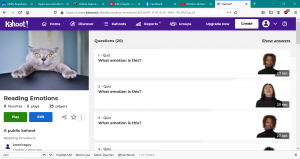9 Chapter 9: Non-verbal Communication
Chapter 9: Non-Verbal Communication

“Do you SEE What I Mean?!?”
This is a picture of my husband and I the day we adopted our first dog, Mocha. While he (in the green looks happy and thrilled to have her in our lives, you might notice I do not have a similar look of confidence! The truth was while I did want to adopt a dog, I was very worried if I’d be able to take on all the responsibilities of pet ownership–letting them out, getting their shots, potty training, I was very scared! Mocha too as you can see, shares our concern! Thankfully, I was able to keep my fears at bay and now can say adopting her was one of the smartest decisions we ever made. Still though, on that day if you had asked me how I was, my verbal communication would likely have been that I would say “I’m fine”, but the photo shows otherwise! If you’re not picking up on the hesitancy in this photo though don’t worry. Non-verbal communication is something we all struggle with.
I LOVE the following video showing principles of non-verbal communication though a Pixar short-film, “For the Birds”. Watch it.
The video nicely introduces some non-verbal concepts. Specifically:
Proxemics–The use of physical space
Physical Appearance–The way we dress and make ourselves look
Kinesics–The use of facial expressions to communicate emotion
Vocatlistics–The tone and loudness of our voice to indicate power and influence
I love at the end of the video the author, James Ham shows how he can apply these principles in his own daily life!
Communication Exercise: Lets Play Kahoot!

In class you will play a Kahoot game on reading emotions. If you’re not in this class but wish to play, just do a search for the Kahoot profile, “Jazzniceguy” and the title “Reading Emotions” and see how you do. Good luck!
TED Talk on the Power of Non-Verbal Communication
This is a really neat video from Ted Navarro who is a retired FBI agent who talks about his experiences of over 25 years and how non-verbal communication can be a great tool in reading emotions. Take a look.
Email Question #9:
Which emotions do you find the hardest to pick up on from other people? When you’re trying to communicate emotions yourself, which ones do you have a hard time showing?
Worksheet #9
This week you should work on practicing showing and reading emotions. Find a friend or family member to do this exercise with. Attempt to communicate non-verbally with them each of these emotions and see if they can figure out what you’re communicating. Then, have your partner do the same thing. Here are the emotions to try:
- Anger
- Sadness
- Happiness
- Frustration
- Laughter
- Pain
- Disgust
- Anxious
- Tired
- Impatient
How did it go? Did you read your partners emotions 100%? Did they read yours? Share your experiences.

